Multiple detachment levels and their control on fold styles in the compressional domain of the deepwater west Niger Delta
ABSTRACT
We interpret recently acquired two-dimensional (2D) and 3D seismic data from the contractional domain of the Tertiary deepwater west Niger Delta, which is an area of current hydrocarbon exploration and development to show that during its gravitational collapse, multiple detachments were active. Detachments are located within (1) what we herein refer to as the ‘Dahomey unit’, (2) the transition between the Agbada and Akata formations (Top Akata) and (3) the Akata formation. Seismic interpretation and quantitative measurements of fault displacements show that the utilisation of different detachments results in contrasting styles of thrust propagation and fold growth. Two geographical zones are defined. In zone A (NW sector of the study area), the stratigraphically shallowest Dahomey detachment is dominant and is associated with thrust truncated folds. In zone B (SE sector of the study area), a stratigraphically lower detachment approximately at the Agbada–Akata formation boundary is associated with thrust propagation folds. A third detachment, within the Akata formation, is locally developed and is also associated with thrust propagation folds. The different deformational histories are probably related to the mechanical stratigraphy and the pore-pressure characteristics of the succession.
INTRODUCTION
Deformation caused by gravity tectonics is common to many deepwater passive margins (Bruce, 1973; Dailly, 1976; Evamy et al., 1978; Doust & Omatsola, 1990; Marton et al., 2000). As petroleum exploration becomes increasingly focused on these deepwater settings, insights into the evolution of the contractional deformation structures that are located in the toe regions of the gravity tectonic system and their suitability as hydrocarbon traps have become important. The deepwater west Niger Delta region (Fig. 1a) is predominantly a compressional structural domain that has recently become the focus of significant oil and gas exploration activity. However, there is currently no documentation of the variability of the fold styles across the area and their structural evolution. This has been due to the historical lack of extensive two-dimensional (2D) and 3D seismic reflection data and well bore calibration of the stratigraphy. Earlier studies were based largely on a few widely spaced reconnaissance seismic lines (Burke, 1972; Delteil et al., 1974; Emery et al., 1975; Mascle, 1976; Lehner & De Ruiter, 1977; Damuth, 1994) and focused upon the mapping of fracture zones and other basement structures, whereas recent publications (Ajakaiye & Bally, 2002a, b; Shaw et al., 2004; Bilotti & Shaw, 2005; Corredor et al., 2005a, b) have focused on studying the gravitational structures (Fig. 1b). Specifically, Corredor et al. (2005a) have carried out structural reconstructions of the progressive development of the fold and thrust belts, describing the style of thrusting and associated folding. They drew links between detachment level and structural style but did not focus on the deepwater west Niger Delta.
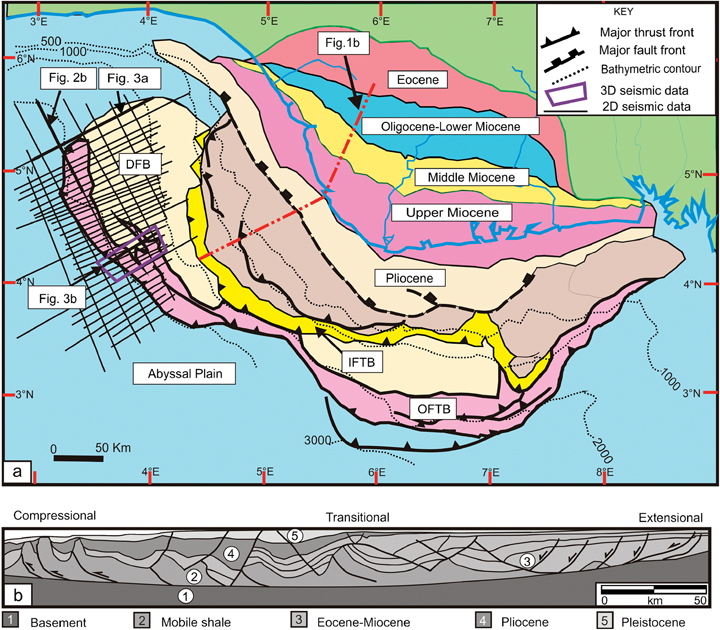
(a) Map of the Niger Delta showing the different structural domains (modified after Damuth, 1994). Note IFTB, DFB and OFTB are equivalent to the inner fold and thrust belt, detachment fold belt and outer fold and thrust belt, respectively. (b) Regional dip line extending across the onshore into the deepwater west Niger delta. Modified after Haack et al. (2000). Vertical exaggeration=2.0.
Thrust-related folds can evolve in many ways (e.g. McClay, 2004). These can be distinguished based upon (a) the shape of the thrust that underlies the fold and the relationship between folding and the kinematics of the thrust tip or (b) whether they have formed above a thrust with no ramp; a lower flat and ramp; or a lower flat, ramp and upper flat. They can also be differentiated kinematically depending on whether they have formed from a fixed tip a propagating tip, or from a thrust that continues beyond the fold (Wallace & Homza, 2004).
The seismic data used in this study were acquired over what are herein termed the (a) inner (proximal) fold and thrust belt, (b) detachment (inter thrust) fold belt and (c) outer (distal) fold and thrust belt of the deepwater west Niger Delta (Fig. 1a). This work complements that of Corredor et al. (2005a), who carried out structural reconstructions in 2D over selected cross sections across the delta. The aim of this paper is to document regional variations in thrust and fold styles and relate these to the stratigraphic characteristics of different detachment levels.
PREVIOUS RESEARCH ON DETACHMENT ZONES
The structural styles of deepwater fold and thrust belts are influenced by a number of parameters including the original mechanical stratigraphy (Erickson, 1996) and the fluid pressure distribution (Ramsay & Huber, 1987). The strength and thickness of the competent layer being deformed control the wavelength, amplitude and asymmetry of thrust-related fold structures (Erickson, 1996). As such, they control the location of a thrust or fold within a multilayered stratigraphic package.
Pore fluid pressure plays a key role in the development of deepwater fold and thrust belts particularly where there are no evaporitic sediments capable of localising a detachment surface. According to the Mohr–Coulomb failure theory, an increase in pore pressure will reduce the effective normal stress, thereby lowering shear strength. The occurrence of excess fluid pressure helps to account for the phenomenon of weak faults in general (Sibson, 1981; Byerlee, 1993) and this mechanical principle can also be applied to the localisation of detachment surfaces in thrust domains (Hubbert & Rubey, 1959). Previous work on fold belts such as that of the Western Gulf of Mexico (Peel et al., 1995) and the Niger Delta (Doust & Omatsola, 1990; Morley & Guerin, 1996; Wu & Bally, 2000) considered detachment to occur on overpressured shales. Where multiple overpressured levels exist in passive margin deepwater settings, multiple detachment levels are not uncommon. Some compressional belts have developed above multiple detachment levels composed of either shale (Rowan et al., 2004), rock salt or other evaporites (Grelaud et al., 2003) or a combination of these (Peel et al., 1995). This has resulted in complex thrust-related fold geometries (Davis & Engelder, 1985; Cobbold et al., 1995).
GEOLOGICAL SETTING
The Niger Delta is one of the largest modern deltas in the world (Doust & Omatsola, 1990; Hooper et al., 2002). It is situated at the southern end of NE–SW folded rift basin, the Benue trough which formed during the Cretaceous opening of the South Atlantic, when the equatorial parts of Africa and South America began to separate (Burke et al., 1971; Whiteman, 1982; Fairhead & Binks, 1991). During the opening of the Equatorial Atlantic in the late Early Cretaceous (Nürnberg & Müller, 1991; Maluski et al., 1995), the trough became filled progressively with Albian and younger post-rift deposits. By the Late Eocene, a delta had begun to prograde over the continental margin following the end of the Palaeocene marine transgression when the Imo Shales were deposited (Damuth, 1994). The delta now consists of a sedimentary prism some 12 km thick with a subaerial extent of about 75 000 km2 (Fig. 1a).
Stratigraphy
The Tertiary Niger Delta can be stratigraphically divided into three diachronous units of Eocene to Recent age that form a major regressive cycle that is broken up into a series of offlap cycles named the Akata, Agbada and Benin formations (Short & Stauble, 1967; Avbovbo, 1978; Evamy et al., 1978; Whiteman, 1982; Knox & Omatsola, 1989; Doust & Omatsola, 1990). The delta prograded over both oceanic and continental basement (Davies et al., 2005; 2, 3). This basement includes a syn-rift and post-rift succession that fills a northeast–southwest and WNW–ESE trending rift structure that formed during the Cretaceous, probably during Aptian rifting of the Equatorial Atlantic (Gradstein et al., 1995; De Matos, 2000; Macgregor et al., 2003). An unconformity (mid-Aptian break-up unconformity) separates the syn-rift and post-rift sediment fill. Above this lies a low-reflectivity package thought to be of Late Cretaceous to Palaeocene age.

(a) Chronostratigraphic diagram showing the regional variability in stratigraphy along a NW–SE transect across the deepwater west Niger Delta. (b) Two-dimensional seismic line showing the abrupt change in stratigraphy between units 1a, 1b and 2. Note that BSM, PASW, units 2, 1a and 1b correspond to the basement (Ajakaiye & Bally, 2002a, b), pre-Akata sediment wedge (see Morgan, 2003, 2004), Akata formation (Avbovbo, 1978; Knox & Omatsola, 1989), Dahomey wedge (Morgan, 2003, 2004) and Agbada Formation (Short & Stauble, 1967; Avbovbo, 1978), respectively.
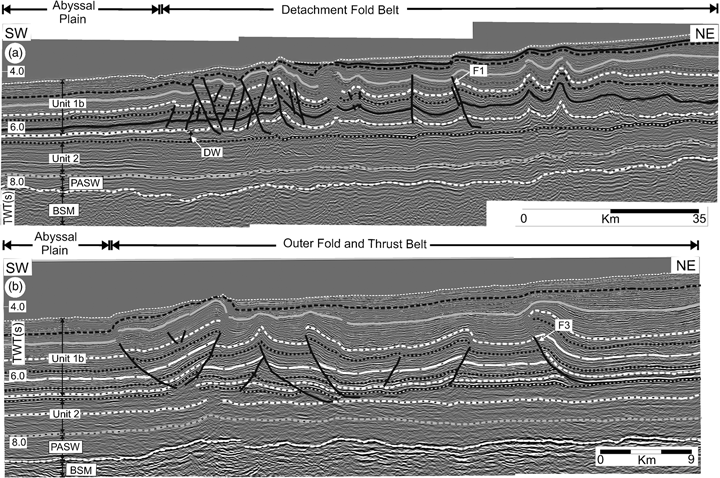
Interpreted seismic lines from (a) the two-dimensional (2D) dataset, (b) the 3D dataset, showing the major stratigraphic subdivisions of the deepwater west Niger delta. The major reflectors defined in this section are the top of the basement, the pre-Akata sediment wedge, unit 2 corresponding to the Akata formation, unit 1a, which is the Dahomey detachment unit and unit 1b, which defines the Agbada Formation. Note the sinusoidal geometry of the Dahomey unit that thins towards the SW direction here and in the SE direction in Fig. 2 but becomes relatively thicker towards the NE. The compressional faults tip out from the thick units marked DW. Older inactive fold features are observed buried without any seafloor expression. The mid-Akata detachment level is clearly defined on the 3D dataset with thrusts propagating from it and showing situations of shale welding. Note the very strong and low-frequency reflector defining the top of the crust and below which no coherent reflections exist.
In addition to the previously described subdivisions, we informally defined two major seismic–stratigraphic packages (units 1 and 2) based upon contrasting seismic amplitude, seismic facies and deformational characteristics. Unit 2 is about 3–4 km thick and comprises a low-reflectivity package, which lacks internal reflection except for a single mid-level high-amplitude reflection (Fig. 3b), which may be related to a detachment (Corredor et al., 2005a). This unit onlaps the older Late Cretaceous to Palaeocene succession, is of marine origin and at the base of the delta, corresponds to the Akata formation of Avbovbo (1978) and Knox & Omatsola (1989). It is mainly composed of marine shales believed to be the source rock for hydrocarbons and some locally developed sand and silt beds. This unit exhibits anomalously low P-wave seismic velocities (∼2000 m s−1) that may reflect regional fluid overpressures (Bilotti & Shaw, 2001). It provides a detachment horizon for large growth faults, located up dip of the study area (Knox & Omatsola, 1989).
Unit 1 is further subdivided into units 1a and 1b (2, 3). Unit 1a is a distinct package between 300 and 600 m thick, consisting of semi-continuous to continuous low-amplitude reflections that are deformed into a series of folds that are clearly evident in the NW of the deepwater region (2, 3). It thins southwards until it is below seismic resolution (∼20 m; Fig. 3b). It is herein termed the Dahomey wedge and is believed to have been sourced from the Dahomey trough of the onshore Guinea basin in the north of this study area (Morgan 2003, 2004). Unit 1b is about 3 km thick below a water depth of over 4000 m and corresponds to the Agbada Formation that has been described by Short & Stauble (1967) from the Agbada-2 well and by Avbovbo (1978). It consists of alternating sandstones and shales deposited by channelised turbidites, debrites and hemipelagites (e.g. Davies, 2003; Deptuck et al., 2003). The sands constitute the main reservoirs in this part of the delta. Sand to shale ratio generally decreases downwards as the formation passes gradually into the Akata formation. The age of this formation is Eocene to Pleistocene (Short & Stauble, 1967; Doust & Omatsola, 1990). The Benin Formation, as described from the Elele-1 well by Short & Stauble (1967), is not encountered in the deepwater region of the Niger Delta (Morgan, 2003).
Structure
The Niger Delta tectonic province is a typical example of a linked regional gravity tectonic system where horizontal translation of the post rift cover is driven by gravitational failure of the margin. This is accommodated by thin-skinned tectonics with extensional, intermediate transitional and downdip compressional domains (Fig. 1b) above one or more detachment levels. Extension occurs on the shelf and is accommodated by growth faults (Weber & Daukoru, 1975; Evamy et al., 1978; Whiteman, 1982; Knox & Omatsola, 1989). A transitional domain is located basinwards of this and is characterised by shale diapirs and their associated inter-diapir depocentres. The compressional domain is sited beneath the lower continental slope and rise, and is characterised by thrust faults and their associated folds.
Thin-skinned compressional deformation is manifest as regularly spaced thrust faults and associated with mainly asymmetric folds. The thrust faults have a regular spacing of between 2 and 5 km and occasionally up to 10 km. These thrusts have developed in an overall seaward-propagating sequence with some out-of-sequence thrusting caused by the reactivation of older in-sequence thrust by the development of new thrust faults through a deformed thrust sheet (Morley, 1988).
The region has been subdivided into three structural domains (Connors et al., 1998; Corredor et al., 2005a)
- (a)
Inner fold and thrust belt (Fig. 1a), characterised by a higher structural dip with an average distance between imbricated thrust sheets of between 1 and 2 km and with the formation of occasional piggy-back basins (Corredor et al., 2005a). The dataset does not extend over this domain.
- (b)
Detachment fold belt (Fig. 1a), characterised by large areas of minor deformation from thrust- or shale-induced folding (thrusting and folding due to shale swelling), with along-transport thrust sheet dimensions ranging from 2 to 5 km (Fig. 3a).
- (c)
Outer fold and thrust belt (Fig. 1a), comprised of local depocentres and both basinward and hinterland verging thrusts. This domain is situated further downdip, with channelised turbidite sands trapped in broad-wavelength anticlines above incipient thrust propagation zones (Fig. 3b).
We divided the study area into two zones; A and B (Fig. 4), according to structural styles. Zone A is in the detachment fold belt located in the NW of the delta and is characterised by the presence of a group of open folds with asymmetric to symmetric geometry, and with minor thrust faults on the steeper limbs. Further to the SE, and along structural strike from zone A, we have defined a second set of thrust faults that are coupled with strongly asymmetric to symmetric, tighter folds, which we have been grouped into zone B. We argue below that the distinctly different structural styles within the compressional domains may be due to detachment zones that underlie the wedge-shaped fold and thrust systems.
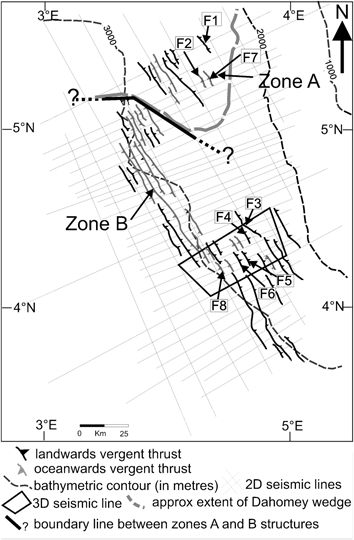
Location map of the study area showing the two-dimensional (2D) and 3D seismic database, the approximate demarcation of zones A and B and the location of faults F1–F8 described in this study. It also shows the approximate extent of the Dahomey wedge.
DATA AND METHODOLOGY
Zone B is partially covered by 1970 km2 of high-quality 3D seismic data acquired in 1999 over water depths of between 1500 and 4000 m and a 1998 vintage of 2D seismic data that has a combined length of 5230 km. Zone A is, however, only covered by 2D seismic data. These data have a dip and strike line spacing of 4 and 10 km, respectively, with a data record interval of 12 s and a 6 km cable length with an airgun source. These data were processed using a Kirchhoff bent ray pre-stack time migration. The 3D dataset has a 6 km offset length and a 12-s record interval. Its processing sequence is similar to that of the 2D data. The datasets are displayed with a reverse polarity (European convention) so that an increase in acoustic impedance is represented by a trough and is black on the seismic data in all figures presented here. The data are displayed in seconds two-way-travel time (TWT). The vertical and lateral resolutions are estimated to be between 10 and 20 m at the top of unit 1 and 100 m at the base of unit 2. Stacking velocities obtained from Morgan (2003) were used to depth convert the seismic data (see Yilmaz, 2001). The overall seismic data quality is considered to be good within the Tertiary section; seismic noise is, however, noted in the dataset, occasionally due to poor migration of seismic energy in areas where there are abrupt lateral velocity changes i.e. in the footwall regions beneath the major thrust planes.
Regional mapping was undertaken to subdivide the seismic-stratigraphy into units 1a, 1b and 2 (2, 3). We then mapped high-amplitude continuous reflections to further subdivide the stratigraphy. These reflections have provided a basis for time stratigraphic interpretation throughout the study area because of the ease with which they can be correlated. This stratigraphic framework was then used as the basis for measuring fault offsets. The high continuity of the mapped reflections was invaluable in aiding correlation across thrust faults within the 3D survey area in particular, because the lateral tips of the thrusts were found to tie beyond the limits of the survey area. Further constraints on the correlation between footwalls and hangingwalls were obtained by linking the regional 2D data to the 3D seismic data.
To analyse the faults, we adopted the ‘displacement–distance’ method developed by Muraoka & Kamata (1983) and Williams & Chapman (1983). This graphical method provides a primary visual representation of the displacement distribution along the fault trace and provides important constraints for the growth history of the thrust (Watterson, 1986; Ellis & Dunlap, 1988).
Depth-converted sections were constructed for each fault analysed. For thrust faults in zone A, the faults were mapped using the widely spaced regional 2D seismic grid, and specific profiles were selected for depth conversion on the grounds that they were most orthogonal to the strike of the thrust faults. It was assumed that because in the better-constrained distal parts of the region, fold axes were mapped parallel to the strike of the thrust faults, the likely motion vector on the thrust faults was orthogonal to fault strike. Hence, the seismic profiles selected are likely to be in or close to the transport direction. This interpretation accords well with what is known of the regional kinematics of the gravity tectonic system as a whole (e.g. Bilotti & Shaw, 2005). For thrust faults in zone B, we selected profiles based on mapping of the thrusts and associated folds using the dense line spacing of the 3D seismic survey (Fig. 5). The parallelism observed on structure maps of the 3D survey area between fold axes and strike of thrust faults again strongly argues for a dominantly dip–slip regime, and hence we selected profiles that were considered parallel to the likely transport direction.
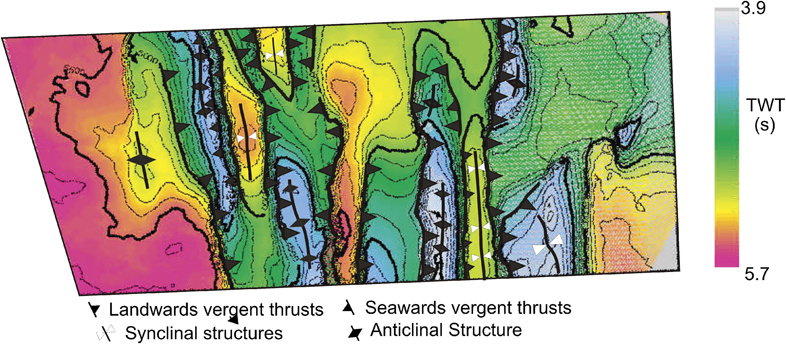
Time structural map of Miocene (10.3 Ma) showing the parallelism between fold axes and the strike of the thrust faults. The figure is dominated by a dip–slip regime. The measurements of the fault displacements were made on profiles that are generally parallel to the likely transport direction.
The displacement (D) values were measured directly from the depth–converted; true-scale sections using 2DMove structural restoration software that allows for depth-converted seismic profiles to be displayed at any scale.
Displacement values were plotted graphically against the distance (X) measured along the thrust fault plane from the upper fault tip to the midpoint position between footwall and hangingwall cutoffs for each specific marker horizon. Displacement values were only recorded for those markers where there was a high confidence in the accuracy of the cross-fault correlation. This method ensured that distortions due to fault plane listricity were not introduced into the graphical display, thus preserving the value of the displacement gradients that can be derived directly from the plots. This approach differs from that used in displacement analysis of extensional faults, where it is more conventional to plot displacement or throw against a distance ordinate measured by projection onto a vertical plane (Walsh & Watterson, 1987).
OBSERVATIONS
In this section, we use representative 2D (6, 7) and 3D (8, 9) seismic lines to illustrate the structural interpretation, pertinent features of the structural geology of the deepwater region and to demonstrate the location of the detachment levels. The displacement distribution of individual thrusts is presented and discussed as a guide to reconstructing the structural evolution.
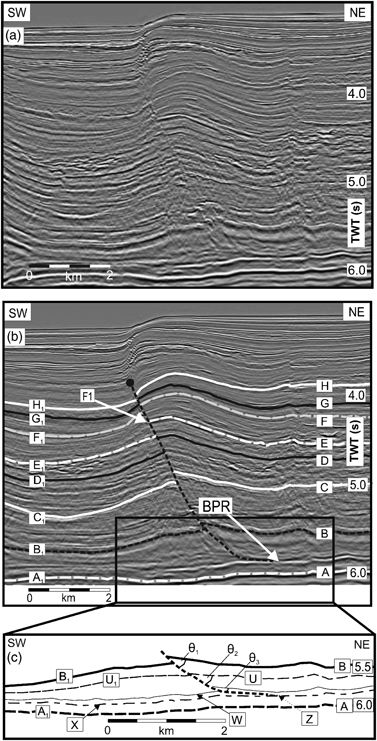
Uninterpreted (a) and interpreted (b) representative seismic section from zone A showing a typical fault (F1) detaching within the Dahomey wedge and (c) an enlarged section of the sole segment where the fault plane reflection terminates within a bedding parallel layer marked as BPR.
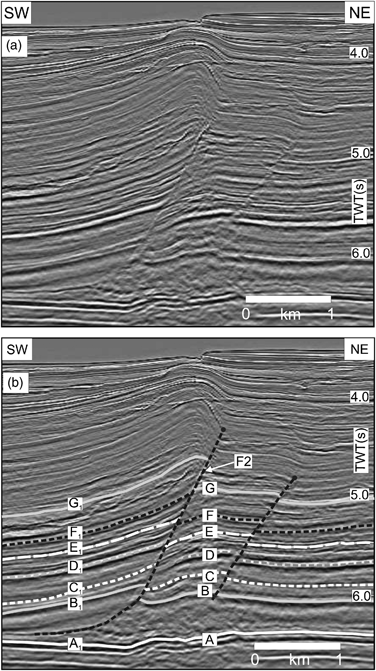
Uninterpreted (a) and interpreted (b) representative seismic section from zone A showing a typical fault (F2) detaching in the Dahomey wedge.
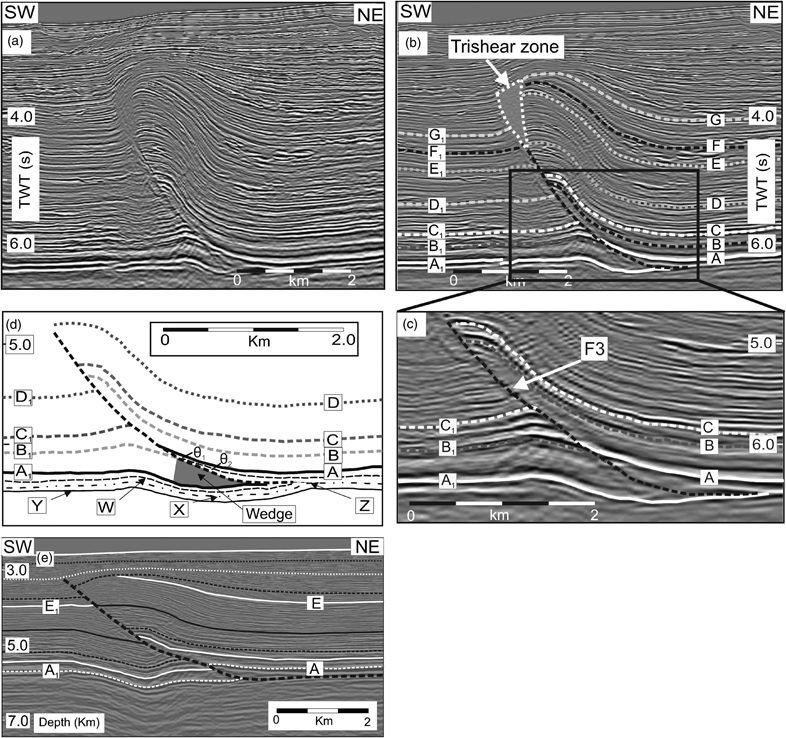
Representative (a) uninterpreted and (b) interpreted seismic section from zone B showing fault F3. Note how the thrust ramps up, forming a thrust wedge. Also observed is the amount of displacement between the footwall and hanging walls. The upper tip is invisible within a trishear zone. (c) A section of the sole segment defining the exact position of the detachment layer. (d) Line drawing of the sole segment describing the relationship between the reflections. (e) A depth-converted seismic section showing fault F3 from which actual displacement measurements were made.
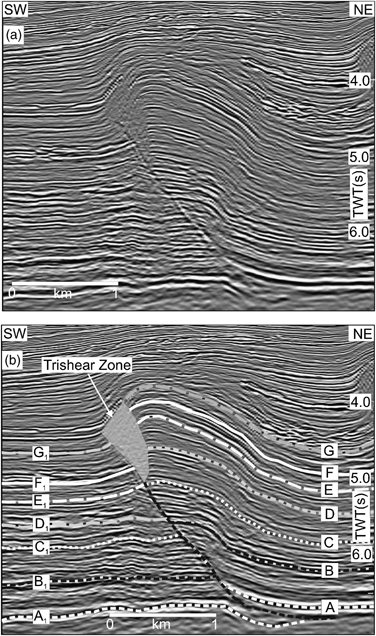
Representative (a) non-interpreted and (b) interpreted seismic section from zone B showing fault F4. Note how the thrust ramps up, forming a thrust wedge on the top Akata formation defined by A–A. The upper tip of the thrust is invisible within the trishear zone.
Fault interpretation and detachment level
The thrust faults in the study area are generally observed to be oceanward verging and striking in a NW–SE direction, but some are landward-verging and out of sequence (Morley, 1988). In general, the thrust planes are listric (concave upwards), steepening upwards to a more planar geometry in the upper parts of the fault planes (6-9). The listric geometry of these thrust faults and the generally asymptotic relationship of the thrust planes with the regional stratigraphy at their base are strongly indicative of the presence of a detachment surface (McNeill et al., 1997). The upper tips are well defined by the shallowest resolvable offset of seismic markers, although loss of signal coherence in shallow reflections around the upper tips sometimes obscures its precise location (8, 9). Individual fault planes range in dip from sub-horizontal, close to the inferred detachment level to approximately 40° close to the upper tip. The steepest, more planar sections of the thrusts were observed to be generally steeper for faults in zone A in comparison with those in zone B. Depth conversion showed that the listric geometry is not simply due to an increase in seismic velocity with depth (Fig. 8e).
Fault planes were interpreted based on the following criteria: (a) abrupt offset of steeply dipping stratal reflections, (b) tracking of fault plane reflections, (c) juxtaposition across the fault plane reflection of dissimilar units and (d) a deterioration in the data resolution beneath the faults as a result of the juxtaposition of faster velocity rocks in the footwall juxtaposed laterally against slower velocity rocks in the hanging wall.
The majority of the thrust faults could be traced from a detachment level at depth upwards to close to the seafloor (e.g. 6-9). The detailed geometry of seismic reflections at the sole of the thrusts is critical for the determination of the detachment levels in zones A and B. The quality of the seismic data generally allows the detachment level to be delineated within a vertical resolution limit of less than 25 m thickness (6-9), and hence contrasting detachment levels observed from faults in zones A and B can be resolved with confidence. The detachment level is defined based on tracing the discordance between reflections in footwall and hangingwall to a position where there is no longer any visible discordance (see Fig. 6c). In the following sections, we examine examples of faults in zones A and B in more detail to illustrate the interpretational approach adopted to identify detachment levels.
Faults in zone A
We illustrate our general approach with reference to a representative example of a fault from zone A (Fig. 6). All angular relationships were measured from true-scale depth-converted profiles. We note that the fault plane exhibits an acute cutoff for reflection B but not for reflection A. Reflection B has a greater cut-off angle with the fault (approximately 28–30°– labelled θ1 in Fig. 6c), than reflection U (approximately 18–20°– labelled θ2 in Fig. 6c) and reflection W (approximately 12–15°– labelled θ3 in Fig. 6c). These values are based on depth-converted sections. Similar relationships are identified elsewhere (Fig. 7). The fault then shallows in dip asymptotically so that the discordance between hangingwall and footwall stratal reflections diminishes to the point where the units are concordant, which, in this case, is coincident with reflection X (Fig. 6c). This is where we pinpoint the junction between the thrust fault and the strata-parallel detachment, which is labelled Z in Fig. 6c, and is the basis for our method of identifying the detachment level. We find that the detachment is often marked by a reflection that has variable and often high amplitude. Similar relationships are identified for most of the faults that we examined (e.g. Fig. 7).
Faults in zone B
In the fault displayed in Fig. 8, reflections A and B both exhibit acute cutoffs. We observed footwall cutoffs at reflection W, but none for reflections W and X (Fig. 8). Again, reflection A has a greater cutt-off angle (approximately 20–25°– labelled θ1 in Fig. 8d) and this reduces downwards to approximately 12–15° (marked labelled θ2) in Fig. 8d. It is also evident that the point where the thrust is interpreted to become layer parallel with stratal reflections (i.e. the point at which it becomes a detachment) defines the apex of a wedge-shaped element (Fig. 8d). Similar geometries have been described by Cloos (1961) and Mitra (2002b). Similar wedge elements are observed at the base of the footwall in Fig. 9. In marked contrast, there are no comparable ‘wedges’ of this type associated with faults in zone A. Also, it is observed that the upper tips of the faults in zone B are characterised by upward-widening triangular region of markedly reduced amplitude (8, 9). These low-amplitude regions bear a striking resemblance to a tip-related shear zone called the trishear zone identified in many outcropping thrusts (Erslev, 1991).
Displacement–distance characteristics
Displacement measurements for eight faults (F1, F2, F3, F4, F5, F6, F7 and F8; located in Fig. 4) were plotted against their stratigraphic position. Faults F1 (Fig. 6), F2 (Fig. 7) and F7 are located in zone A, whereas faults F3 (Fig. 8), F4 (Fig. 9), F5, F6 and F8 are situated in zone B. Graphical plots of displacement (D) versus distance (X) are presented in 10, 11. Errors amounting to aprroximately 10% in these measurements include the sampling interval of 4 ms, the errors in positioning due to uncertainty in the migration velocities and interpretational errors.
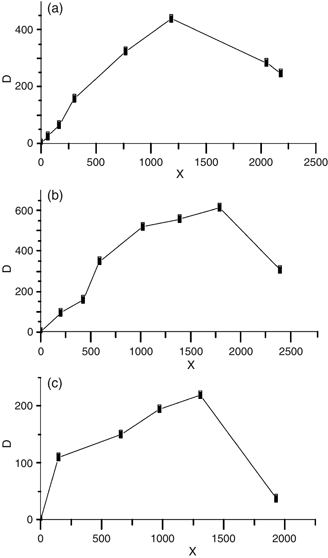
Displacement–distance plots for thrusts F1, F2 and F7 from zone A.
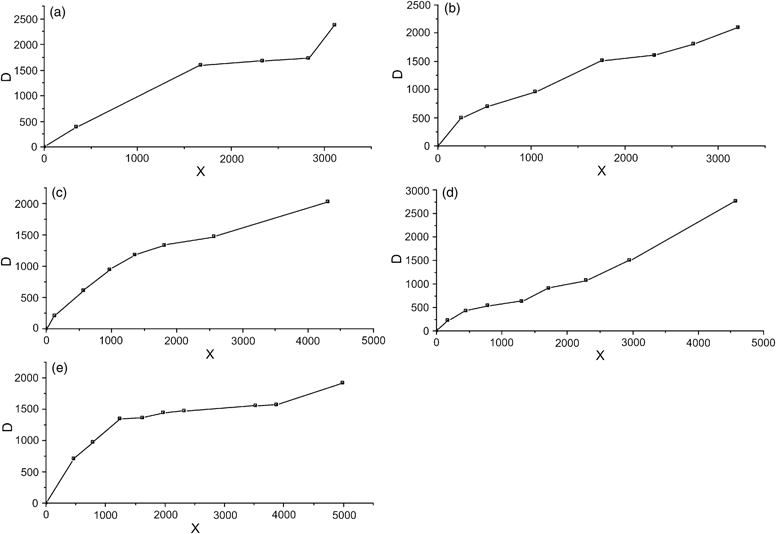
Displacement–distance plots for thrusts F3, F4, F5, F6 and F8 from zone B.
Zone A
All the thrust faults in zone A characterised by displacement–distance plots that show an increase in displacement from the upper tip, to a position approximately midway down the main thrust ramp, where the displacement is a maximum, and from which point to the detachment position, show a clear decrease in displacement values. Three examples of this type of pattern are presented in Fig. 10. In the case of fault F1, for example (Fig. 10a), the displacement maximum recorded at the mid-ramp position is 438 m and decreases to 247 m at the deepest horizon before the detachment. This reduction in displacement downwards is too large to be within the error range, and thus appears to be a genuine feature of this example. Similar patterns of asymmetrically peaked displacement–distance patterns can be seen for faults F2 and F3 (Fig. 10b and c), where there are even more pronounced downward decreases in displacement values from the maximum position. These observations are highly significant in the context of overall kinematic analysis (Williams & Chapman, 1983) in that the displacement clearly decreases as the detachment is approached.
Zone B
In contrast to the thrust faults in zone A, those in zone B are characterised by displacement–distance plots that show an increase in displacement from the upper tip downwards to the last measurable horizon offset close to the detachment position. Five representative examples of displacement–distance plots for zone B faults are presented in Fig. 11. The general increase in displacement values downwards from the upper tips can either be quite linear with a constant displacement gradient (e.g. upper part of Fig. 11a), or more step-like (Fig. 11b), or bipartite, with a larger upper gradient, and a smaller deeper gradient (Fig. 11b and c). The displacement gradients are similar to those reported for normal faults, and range from 0.2 to over 3.0. The larger values are almost certainly indicative of stratigraphic thinning in the region of the upper tip, rather than the result of ductile strain associated with fault propagation. The deepest values in all cases were measured quite close to the detachment, so the progressive increase in displacement as the detachment is approached stands in marked contrast to the reduction in displacement observed at the same position for zone A faults. This contrast in displacement characteristics is universal for the faults in the two zones, respectively, and is considered further below with a view to explaining the difference in behaviour.
DISCUSSION
Multiple detachments
One of the most important observations made from the seismic interpretation is that the thrust planes are seen to detach into two separate levels in the deepwater region of the west Niger Delta. A third (mid-Akata) detachment has also been identified but has only local significance in zone B. These detachments are interpreted to be located within spatially extensive and mechanically weak units, based on long-range correlations of the stratal units containing the regional detachment levels. Over 95% of the combined fold-thrust structures mapped on the regional 2D and 3D seismic data detach into either of these two levels. These two detachments are informally termed the Dahomey and Top Akata detachments. The Dahomey detachment (within the Dahomey ‘wedge’) is a zone rather than a narrowly defined level, with a thickness of between 100 and 120 m. It is characterised by parallel internal reflections with some bedding parallel slip producing minor deformation and allowing the definition of the detachment interval. This thick detachment ‘zone’ is conceivably due to the presence of a specifically weak lithology, such as a condensed interval with high organic content, or due to specific clay mineralogy (e.g. smectite rich). In contrast to the Dahomey detachment, the Top Akata detachment shows no buckle-type minor deformation. It has a thickness of between 40 and 70 m.
Displacement patterns
The displacement–distance profile exhibited by faults in zone A (Fig. 10) have been shown to be characterised by a distinct peak in displacement value some distance above the detachment. It is not possible to constrain whether the displacement continues to diminish along the flat portion of the detachment, possibly even to a lower tip zone, as has been suggested for some thrust faults (Pfiffner, 1985; Eisenstadt & De Paor, 1987). What is clear, however, is that the peak value occurs approximately midway up the post-detachment stratigraphy, relative to the overburden present at the onset of thrusting. The displacement–distance plots of these faults thus bear some resemblance to the ‘C’-type plots described from small normal faults by Muraoka & Kamata (1983) and for thrust faults by Williams & Chapman (1983).
The ‘C’ type of displacement–distance plot implies that the thrust fault loses displacement both updip and downdip from a point near the centre of the thrust, with considerable displacement gradients in both directions (and presumably, therefore, laterally too). Small variations in the profile are attributed to lithological effects such as bed-pervasive ductile thickening within weaker shale layers. The relative smoothness of the profile could be interpreted to indicate an essentially uniform lithology throughout the section consistent with the deepwater depositional setting. The recognition of displacement gradients implies that the wall rocks must be strained in order to accommodate the displacement variation (Walsh & Watterson, 1987), which raises interesting questions about discrimination between thinning due to wallrock strain versus thinning due to syn-kinematic changes in accommodation space.
Previous studies have linked the recognition of a ‘C’-type displacement pattern to a specific propagation and growth model, in which the site of initiation of the fault coincides with the locus of maximum displacement on the fault (Walsh & Watterson, 1987). More recently, this concept has been challenged in cases where strong rheological contrasts in the faulted succession have been shown to skew the position of maximum displacement away from the initial locus of propagation (Wilkins & Gross, 2002). In some previous models for thrust nucleation, analysis of this type of displacement pattern has been equated with initial propagation in the ramp region of a ramp-flat thrust structure, with both updip and downdip propagation as strain accumulates (Pfiffner, 1985; Eisenstadt & De Paor, 1987), and we follow their interpretation in suggesting that the ‘C’-type patterns we observe are probable indicators of a localised nucleation site above the detachment, with later propagation of the thrust downwards into the detachment. This propagation sequence is thought by some workers to be characteristic of faulted detachment folds (Mitra, 2002b), alternatively referred to as thrust-truncated folds (Wallace & Homza, 2004). This interpretation is similar to that proposed for a thrust and fold in the inter thrust sub-domain of the eastern part of the deepwater Niger delta, which was termed a ‘thrust-faulted detachment-fold anticline’ (Shirley, 2002).
In marked contrast, faults in zone B (8, 9) show a steadily increasing pattern of displacement with distance from the upper tip to the last measurable point close to the detachment level (Fig. 11). As with faults in zone A, the distribution of displacement on the flat portion of the detachment is unknown. Because the displacement values are unconstrained along the detachment, we cannot infer anything about nucleation and propagation other than to link the distinctive displacement gradients across the entire post-detachment stratigraphic section to thrust propagation in the transport direction. As noted earlier, the folds in zone B are seen to be more open than folds in zone A, which could possibly be linked to the differences in displacement patterns on the thrust faults associated with the folds in the two areas, and the relative partitioning of contractional strain between the thrusts and the folds. The parts of the displacement–distance plot with 0 slope may be indicative of fault segments that have propagated with little associated wall strain (Muraoka & Kamata, 1983; Suppe & Medwedeff, 1984, 1990).
In summary, it can be concluded that there are substantial differences between the thrusts in the two zones, both in their displacement patterns and in their relationship with associated folds. Before addressing the key question of why there are differences between these two zones, we first present a model for thrusting and folding in zones A and B based on our kinematic observations linked to those of previous workers.
Descriptive model for thrust propagation and fold-style development
Zone A
In this zone, the dominant structural fold type is the thrusted detachment fold, which we suggest resulted from buckling of a stratified succession, and that initially bent without rupture, leading to the formation of an open anticline and syncline pair. It is proposed that the fold then tightened and became more asymmetric as deformation progressed. When the fold could no longer accommodate the strain by folding, ruptures localised and linked on the steeper limb, producing a thrust that broke through the forelimb of the fold and finally connected to a mobile detachment layer within the Dahomey unit. These types of structure have been called break-thrust folds (Dixon & Liu, 1992; Fischer et al., 1992), thrusted detachment folds (Mitra, 2002b) or thrust-truncated folds (Wallace & Homza, 2004), and have been described mainly from kinematic models. The term fold-accommodation fault (Mitra, 2002a) would not be appropriate as these type of faults do not connect to a major detachment, which these structures do. This is critically supported by several examples of thrust faults on the limbs of detachment folds that are at an early stage in their development (Fig. 12), in which the thrust has not propagated downwards to connect with the detachment. The presence of this buckled bed with lack of a thrust during shortening may be modified by later truncations of a fault (Jamison, 1987; Mitra, 1990; McNaught & Mitra, 1993). The difference is also shown by the variation in nucleation pattern and the stratigraphic position of the detachment.
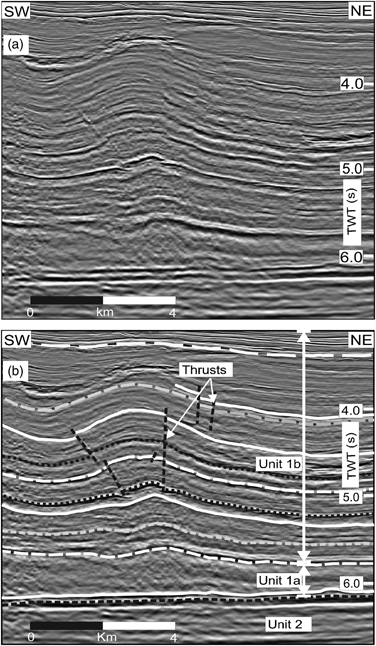
Non-interpreted (a) and interpreted (b) seismic section showing early stage of development in a faulted detachment fold. Fault and deformation zones form on steeply dipping rotated segments on both limbs, resulting in pop-up-like structures.
Zone B
In zone B, we suggest that in contrast to zone A, the fault propagation folds developed coevally with thrusting and consumed slip at the tips of blind thrusts (Suppe & Medwedeff, 1984; Suppe, 1985; Marshak & Wilkerson, 2004). As the thrust tip migrated, strata are folded in front of it and are eventually breached by the thrust. The upward decrease in displacement observed on the displacement–distance plots is quite typical of a thrust-propagation fold but is not really diagnostic of this class of structure (Mitra, 2002b; Wallace & Homza, 2004). Here, the folds develop in front of the upper tip of the developing thrust as the ramp propagates up section (see Mitra, 1990, 2002b).
Controls on detachment level
The detachment layer in zone A, which is the unit referred to as the Dahomey ‘wedge’, is over 100 m thick beneath the entire main structures in the area, and is clearly a mechanically weak unit that relates in some way to its lithology. In contrast, in zone B, the detachment level is defined across a much thinner interval corresponding to the Top Akata. This detachment level may be due to the presence of overpressure build-up as revealed from a velocity drop (Morgan, 2003) and shown by the high amplitude and reverse polarity reflections (8, 9). Wells drilled in nearby areas have proved this to be the case (large pressure ramp at the Top Akata). So overpressure is the likely mechanism for the Top Akata detachment level.
Stewart (1996) argued that detachment layer thickness played a critical role in the style of shortening in contractional settings. He showed that if a detachment occurred within a thick layer, significant fold amplification could be expected before thrusting. If the detachment layer is thin, shortening quickly leads to thrust nucleation and thrust propagation folds could be expected thereafter.
Combining the mapped distribution of detachment folds of zone A with the regional distribution of the Dahomey wedge detachment ‘layer’ (Fig. 4), it can be seen that the zone of detachment folds coincides exactly with the mapped extent of the Dahomey wedge. Adopting the argument advanced by Stewart (1996) on the influence of detachment layer thickness, we can therefore simply propose that the main factor controlling the development of two distinct structural styles in the deepwater fold belt is the presence or absence of a thick detachment layer. Where present, detachment folds develop, with differing degrees of associated thrusting out of the limbs. Where absent, instead, the shortening slope sediments detach at the Top Akata pressure ramp, which forms a discrete and thin detachment level, above which the nucleation of early thrusts is encouraged, which evolve into the distinctive high strain, thrust propagation folds.
By analogy with the results of numerical and analogue modelling of the factors affecting fold style such as differences in competency and stratigraphic thickness between the upper Dahomey detachment and the underlying Akata detachment units have probably affected the style of folding we have observed. The Dahomey unit is relatively incompetent, and thus is able to move into the cores of the developing anticlines from the adjacent synclinal hinge. We suggest that this incompetent unit allowed the growth of the fold by flexural slip while maintaining parallel folding, bed length and thickness. The deformation from the top Akata unit may primarily be due to internal ductile strain or flexural slip as indicated by thickness changes across fold limbs and widely spaced bed parallel slip surfaces.
IMPLICATIONS
Understanding the evolution of structures in the deepwater west Niger delta is necessary in order to avoid the improper assessment of not only the trap geometry, location, shape, size, depth and vertical extent but also the reservoir, seal, source and migration. We find that fault propagation folds generally form tighter anticlines than thrusted detachment folds and as such would have different type and size of trap. This may be supported by the fact that most of the world class discoveries are located within zone A where the thrusted detachment folds are the dominant structure with low relief and high area as compared with zone B, which is dominated by thrust propagation folds that have higher relief but with smaller area.
The interpretation of these different structures will have contrasting implications for the presence and geometry of the fault type whether they impede the migration of fluid or result in compartmentalisation of the reservoirs. The structures are likely to control hydrocarbon migration in that in the zone A area, there may be no fault-linking source to trap and reservoir, whereas elsewhere (zone B) there generally would be a link. Therefore, we propose that the risk of a trap not being on a migration pathway is higher in zone A structures. This is particularly true for the early developmental stages of thrusted detachment folds, where a through-going fault linking trap to source has not fully developed.
CONCLUSIONS
Our study has shown that in the deepwater fold and thrust belt of the Niger Delta, there is a strong dependence of structural style on the thickness and lithology of the detachment unit. In zone A, folds formed in response to ductile deformation of the inherently weak Dahomey wedge, which was susceptible to flow due to the regional overpressure developed at or around the top of the Akata formation and shown from the greater amount of shortening that could be due to lithologic changes. In zone B, the folds are more clearly linked to thrust propagation.
This study has shown that two distinct structural patterns are possible within the deepwater west Niger Delta. They are the thrusted detachment folds in zone A and the thrust propagation folds in zone B. The two structural styles can be distinguished on the basis of markedly contrasting displacement–distance plots (Fig. 13). More symmetrical displacement patterns with a discrete maximum in the mid-ramp position are found for all the thrusts in zone A associated with detachment folds, whereas the thrust propagation folds are associated with a downward-increasing pattern of displacement towards the detachment.
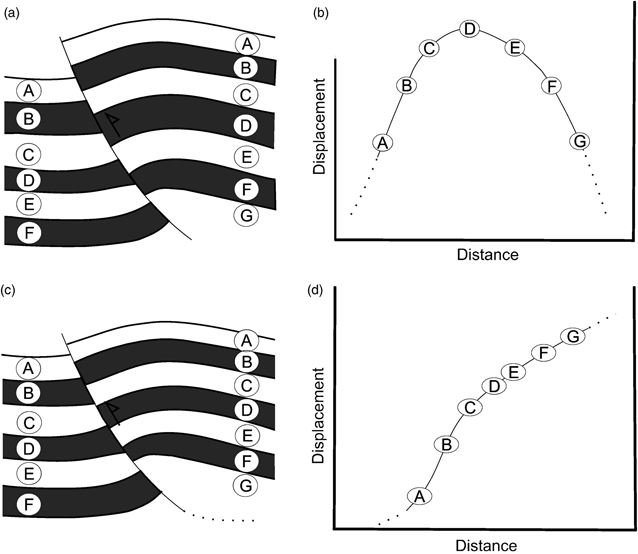
Model showing thrust-related fold types and their associated displacement–distance profiles. (a) Thrust-related fold type with apparent nucleation point at the centre of the fault. (b) Idealised displacement–distance pattern from a ‘C-type’ fault (after Muraoka & Kamata, 1983). (c) Thrust-related fold type showing nucleation point at the base of the fault. (d) Idealised displacement–distance pattern from a type II fault. Note here that the nucleation point corresponds to a detachment level. Displacement values are projected from a perpendicular down to a horizontal line from the midpoint between the hanging wall and footwall cut-offs.
ACKNOWLEDGEMENTS
Funding from Prime Energy Resources, Lagos Nigeria and Chamberlain Oyibo is gratefully acknowledged. Veritas DGC Ltd are thanked for the provision of seismic data and permission to publish the results of this study. We are grateful to Simon Higgins, Paivi Heinio and the 3DLab for discussion. We thank Schlumberger and Midland Valley for the use of seismic interpretation and depth conversion software, respectively. We would like to thank Peter Cobbold and an anonymous reviewer for their constructive and helpful reviews.




